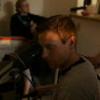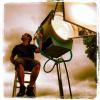-
Posts
82 -
Joined
-
Last visited
About Chris Walters
- Birthday 03/07/1987
Profile Information
-
Occupation
Cinematographer
-
Location
Los Angeles
Contact Methods
-
Website URL
http://www.cswalters.com
Recent Profile Visitors
2,117 profile views
-

United States of Tara Season 1 DVD
Chris Walters replied to David Mullen ASC's topic in On Screen / Reviews & Observations
Beautiful Work David. I found myself enraptured in the lighting! I really enjoyed and learned from just watching a few episodes. I really love how natural everything looks. So much variation in tone from dark to light. I hope I can achieve such looks like this on my future projects! Great work! Can't wait to see more. -

What does it take to be ASC?
Chris Walters replied to Michael Palm's topic in Business Practices & Producing
Thats pretty cool stuff, but i always hesitate to think shooting a feature is really that big of a deal. I mean I can take my dvx and shoot a feature with natural light. A feature is just a length of time and doesn't mean its of real quality and substance. Don't get me wrong it could be a large budget with properly paid crew and thats great, but I my pet pieve is when people mention the word feature and get all worked up about it. But the school looks great though I might want to check it out. Kevin I agree completely about the grips and gaffers mix up. Its real frustrating coming to a set as the actual gaffer and you got 2-3 other people thinking its their position. It is a big film school problem and people need to be taught all the different positions of a production besides producer DP director writer, and sound.. good luck to everyone. there are plenty of jobs out there for all of us. Not all of us need to be blockbuster DPs. I for one would be very happy as a gaffer or shooting Industrials. Its all about finding a niche and being happy. Good luck.... -
I'm just about to graduate from Cal State Northridge and I'm trying to determine the best route to become a cinematographer, but also be able to provide for myself on the road to my goals. I have worked on over 60 shorts and features mostly on the lighting side (gaffer, BB Electric, lighting tech), but have recently been getting into camera side. My question is should I intern at panavision and possibly work there, earning steady income but away from sets, but with equipment? Or (and there are several of those) should I use my contacts and just work on sets immediately? Or should I purchase a camera and just start shooting smaller projects and hopefully work my way up the totem pole that way? I know its a complicated question and depends a lot of what I personally choose, however I was wondering if anyone has had a similar decision to make and chose a certain path or if anyone has any say on the matter, all opinions are appreciated. Thank you and good luck to all of you in all your endeavors. Chris
-
I guess that would be what conrad hall would call a happy accident. Thank you for sharing and good luck on the next one because I definitely would like to see more. Chris
-
Hey great job David. I was fortunate to catch this on a plane to europe. I was looking at your montage and you showcased a lot of shots with nice beams of light coming through doors and windows.. I was wondering what type of unit you chose to get those beams... Xeons, fresnel or pars? I suppose you can do it either way but do you prefer a certain kind to another? Again great work and I look forward to see much more of your work in the future. Chris
-
Thanks Marc... I agree with the separation. I was cutting them together recently and it just felt odd to have dolly and crane shots to cut to talking heads. The "filmic" feel should help me decide what stays and goes. Chris
-
Hey guys, I'm still in school but I've been doing plenty of decent film and video projects to put together for a reel. I've done weddings, short narratives, documentaries, and industrial pieces. My question is should I compile all of these different genres together on one or make separate reels for each or just the narratives. Also in terms of music, is a song with words to distracting? Are there any styles of music that are better for reels that you could reccomend? Thank you for your input Chris
-
I actually was a 1st AC for a USC graduate project that shot with the red and I'm still riding the fence if I like the camera. It still has a lot of things to work out, but they are mostly convenience problems. I was pulling focus blind which wasn't all that terrible because I have a good judgement on distance but its still a little scary not being able to see if my marks are all correct. I had a lot of fun configuring the body, battery, and hard drive to make it easy on the steady cam op. Another problem is the battery life, its basically a computer it sucks the battery dry and make sure you have two chargers. Even though each charger holds two batteries and we had four fresh ones at the start of the day we ended up on AC power the last hour or so of each day. Which you really need PAs to wrangle the charger and all the other cables coming out of this thing. I also don't like the mini bnc only because they break really easily. The steady cam op rested his rig on his shoulder and the cable got stuck on it and he was barely lifting it up so I could release it and it just snapped. I'm disappointed there is no view finder yet I guess thats in the works. But the images are really nice. Still looks HD crisp to me which I'm not a big fan of, but really easy setting adjustments, playback and very wide latitude make it a nice choice for low budget digital features. Just wait a few more updates and it should be a major player. Chris Walters
-
Thanks again David. I'm sorry I missed you when you came to Cal State Northridge. I was in that cinematography class you came with Mr. Dibie. I was on another shoot with Nancy Schrieber. I had a whole lot of questions I guess I'll have to spread out on this server lol :-P It was also a pleasure meeting you at Panafest in the theater for the genesis/film comparison. Hope to meet you again soon.
-
Thank you sirs. That did clear it up a lot for me. I figured film dailies were more of a luxury so I shouldn't expect them for me anytime soon. :-P Since both of you mentioned it what would be the workflow for a DI. I think I have the basic idea of scanning the negative at a high res or SD to edit depending on budget then EDL to laser it out to film. Is that the just of it?
-
I've only released to digital and i'm trying to understand the whole workflow. I've been reading on the printer lights and timed dailies and everything done for a workprint. Do you time your workprint/dailies and then telecine that to edit off of or just the original negative. I know that the dailies are positive prints and thought telecine was with the negative. Correct me if i am wrong here. Seems like a waste to do a internegative at this point, but if thats the process so be it. Do you actually do anything with the dailies or work print it self if you are editing digitally but negative cutting or are they just for checking your previous days work? More of a luxury if you have the funds. Obviously I'm a student and i'm trying to get a handle on this for my senior films coming up. Thank you for any advice that follows. Chris
-
I have not seen this films yet but they are definitely on my netflix list.... I love this guy's hair I don' t know what decade its from, but he sports it nicely.
-

Xenon lights and when to use them
Chris Walters replied to Lindsay Mann's topic in Lighting for Film & Video
All in a days work for K. Zanitski lol :P -
In regards to your question about the fstops don't feel bad for not knowing... everyone has to learn at somepoint in their careers and trust me everyone is still learning even Mr. Mullen would gladly admit he is still learning. Thats what makes this craft so great its a never ending search for answers. Mr. Mullen knows a lot more than me and I hope he understands I used him as an example because he is so well versed in cinematography. Back to your question. The Fstop scale can be calculated but you have to know at least two numbers to find out the rest. More or less it just needs to be memorized and you will remember it the more times you go over it. Here it is 1, 1.4, 2, 2.8, 4, 5.6, 8, 11, 16, 22, 32, 45 If you notice every other number doubles from the previous. Thats because twice as much or half as much light is reaching the film or sensor depending which direction you go on the scale. In between these numbers are what are called 1/3 of a stop but you don't really need to memorize those at first. But 1/3 stops are the smallest increments that make a significant difference in exposure that the normal eye can tell. However, there are some DPs who can see down to the tenth of a stop difference and they are truly seasoned in their craft, but it is not necessary at this point. Best thing to do is keep going over these numbers and you'll remember them in no time... or just remember two consecutive numbers and you can double or half them to find the others Good luck and never stop searching for answers



